 ACKNOWLEDGMENTS
ACKNOWLEDGMENTS
I must begin by thanking all the people at the Charles E. Tuttle Company for seeking me out and supporting me in the creation of this book. Thank you, too, Professor Nakamura Hajime, for giving me my start in Japan, and Wybe Kuitert, for your friendship and many insightful comments that made this a better book. To Kinoshita Ryoichi, many, many thanks for your constant support. Also, I am very grateful to Monica Bethe, Richard Tanter, Tacy Apostolik, Andrew Hare, and everyone else who opened up new worlds to me by lending me your books. Yoshiko Mastubara is owed special mention for her ink brush characters which complement the pages on aesthetics. There are three people without whom this book would not be what it is and to whom I owe a special debt of gratitude:
hashi Haruz, for his beautiful garden photographs. Mr. Ohashi, who started taking photographs just about the year I was born, has made photographing Japanese gardens his life's work and has at least thirty books on that subject.
John Einarsen for giving form to my words. A resident of Kyoto for the last fifteen years, he is best known as the chief editor and art director of Kyoto Journal, an excellent quarterly magazine on Japan and Asia.
Preston L. Houser for his clear, editorial insight. Mr. Houser is author of Invitation to Tea Gardens: Kyoto's Culture Enclosed and the CD-ROM Kyoto Gardens: A Virtual Stroll Through Zen Landscape.
This book is the result of eleven years of research and design work. It is impossible to list all the many, many people who have helped me along the way: the scholars who shared their thoughts with me and the gardeners who gave me insights into their world. I am very grateful to all of you.
And, most of all, to Momoko and Kai, who made it all worth it just by being there.
BIBLIOGRAPHY
BOOKS IN ENGLISH
Addiss, Stephen. The Art of Zen, New York: Harry Abrams, Inc. Publishers, 1989.
Aston, W.G. Nihongi: Chronicles of Japan from the Earliest Times to A.D. 697, Tokyo: Charles E. Tuttle Company, 1972.
Awakawa, Yasuichi. Zen Painting, Tokyo and New York: Kodansha International Ltd., 1970.
Carter, Dr. Jon and Covell, Alan. Japan's Hidden History: Korean Impact on Japanese Culture., Elizabeth, NJ, Seoul: Hollym International, 1984.
Elison, George, and Smith, Bardwell L., editors. Warlords, Artists, and Commoners, Honolulu: University of Hawaii Press, 1981.
Engel, Heinrich. The Japanese House.,Tokyo: Charles E. Tuttle Company, 1964.
Hall, John W. and Takeshi, Toyoda, editors . Japan in the Muromachi Age. , Berkley, Los Angeles, London: University of California Press, 1977.
Hempel, Rose. The Golden Age of Japan 794- 1192, New York: Rizzoli International Publications, Inc., 1983.
Hisamatsu, Sen'ichi. The Vocabulary of japanese Literary Aesthetics, Tokyo: The Centre for East Asian Cultural Studies, 1963.
Houser, Preston. Invitation to Tea Gardens, Kyoto: Mitsumura Suiko Shoin, 1992.
Itoh, Teiji (translated by Friedrich, Ralph and Shimamura, Masajiro). Space and Illusion in the Japanese Garden, New York, Tokyo, and Kyoto: Weatherhill/Tankosha, 1983.
Itsuzu, Toshihiko and Toyo. The Theory of Beauty in the Classical Aesthstics of Japan, The Hague, Boston, London: Martinus Nijhoff Publishers, 1981.
Kane, Daniel R. "The Epic of Tea: Tea ceremony as the Mythological Journey of the Hero," Kyoto Journal, Vol. # 1, 1987, pp. 12-22.
Kato, Shuichi. Form, Style, and Tradition, Tokyo, New York and San Francisco: Kodansha International Ltd., 1971.
Kodnnsha Encyclopedia of japan, Tokyo, New York: Kodansha, 1983.
Koren, Leonard. Wabi-Sabi for Artists, Designers, Poets, and Philosphers, Berkley: Stone Bridge Press, 1994.
Kuck, Loraine . The World of the Japanese Garden, New York and Tokyo: Weatherhill, 1984.
Kuitert, Wybe. Themes, Scenes, and Taste in the History of Japanese Garden Art, Amsterdam: J.C. Gieben, Publisher, 1988.
Levy, Ian Hideo. Man'ysh: Volume One, Princeton, NJ: Prince to n University Press, 1981.
Lip, Dr. Evelyn . Feng Shui; Environments of Power, London: Academy Group Ltd., 1995.
Mason, Penelope. History of Japanese Art, New York: Harry N. Abrams, Inc., Publishers, 1993.
McCullough, Helen Craig. Tales of lse. , Tokyo: University of Tokyo Press, 1968.
Morris, Ivan . The World of the Shining Prince, England: Penguin Books Ltd., 1964.
Murakami, Hyoe, and Seidensticker, Edward G., editors. Guides to japanese Culture, Tokyo: Japan Culture Institute, 1977.
Nakamura, Makoto. The Twofold Beauties of the Japanese Garden, International Federation of Landscape Architects (I.F.L.A.) Yearbook, 1986/87, pp. 195-198.
Naito, Akira. Katsura; A Princely Retreat, Tokyo, New York and San Francisco: Kodansha International Ltd., 1977.
Nelson, Andrew Nathaniel. The Modern Reader's Japanese-English Character Dictionary: Second Revised Edition, Tokyo: Charles E. Tuttle Company, 1974.
Nishi, Kazuo, and Hoz umi, Kazuo, translated by Horton, H. Mack. What is Japanese Architecture? Tokyo, New York: Kodansha International Ltd., 1983.
Nitschke, Gnter. The Architecture of the Japanese Garden: Right Angle and Natural Form, Koln: Benedikt Taschen, 1991.
Okakura, Kakuzo. The Book of Ten, Tokyo: Charles E. Tuttle Company, 1956.
Richards, Betty W., and Kaneko, Anne. Japanese Plants: Know Them & Use Them, Tokyo: Shufunotomo Co. Ltd., 1988.
Rodd, Laurel Rasplica . Kokinshu, United Kingdom: Princeton University Press, 1984.
Sansom, G.B. Japan; A Short Cultural History, Tokyo: Charles E. Tuttle Company, 1931. The Tale of Genji, translator, Seidensticker, Edward G. Tokyo: Charles E. Tuttle Company, 1976.
Sakuteiki; The Book of Garden, translator, Shimoyama, Shigemaru. Tokyo: Town and City Panners, Inc., 1976.
Slawson, David . Secret Teachings in the Art of Japanese Gardens, Tokyo and New York: Kodansha International Ltd., 1987.
Stanley-Baker, Joan. Japanese Art, London: Thames and Hudson,1984.
Treib, Marc, and Herman, Ron. A Guide to the Gardens of Kyoto, Tokyo: Shufunotomo Co-. Ltd., 1980.
Ueda, Makoto. Literary and Art Theories in Japan, Ann Arbor, Michigan: Center for Japanese Studies, The University of Michigan, 1967.
Varley, Paul H. Japanese Culture; A Short History, Tokyo: Charles E. Tuttle Company, 1973.
Wright, Tom. Zen Gardens, Kyoto: Mitsumura Suiko Shain, 1990.
Yamazaki, Masafumi, editor. Process Architecture #116; Kyoto; Its Cityscape Traditions and Heritage Japanese and English), Tokyo: Process Arcitecture Co., Ltd., 1994.
Yoshikawa, Isao. Chozubachi; tienbi no zokei (Japanese and English), Tokyo: Graphic-sha, 1991.
Yoshikawa, Isao. Zendera no niwa (Japanese and English), Tokyo: Graphic-sha,
BOOKS IN JAPANESE
Amino, Yoshihiko. Nihonron no shiza, Tokyo: Shogakkan, 1991.
Hasegawa, Masami. Nihon teien no genz, Kyoto: Shirakawa Shain, 1978.
Hasegawa, Masami. Nihon teien ysetsu, Kyoto: Shirakawa Shain, 1983.
Hida, Norio. Teien shokusai rekishi; Nihon bijutsu kogei, 1990-1991.
Hisayama, Kikuo. Fiirudo gaido: daimonji yama, Kyoto: Nakanishiya Shuppan, 1991.
Kanji-gen, Tokyo: Gakken, 1988.
Kogo daijiten, Tokyo: Shogakken, 1983.
Kojima, Noriyuki, et al. Nihon koten bungaku zensh: Man'ysh, Tokyo: Shogakkan, 1990.
Kyoto no meien: Sana kachi to hensen, Kyoto: Kyotoshi Bunkazai Bukkusu Dai 9 Sh, 1994.
Kyoto no teien: Iseki ni mieru heian jidai no teien, Kyoto: Kyotoshi Bunkazai Bukkusu Dai 5 Sh, 1990.

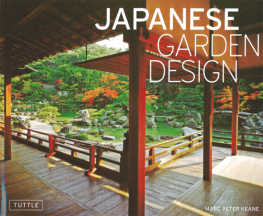
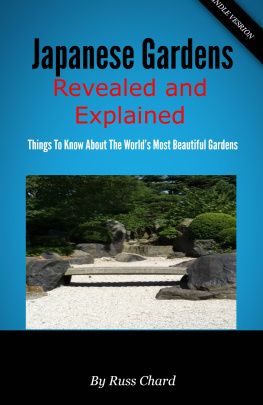

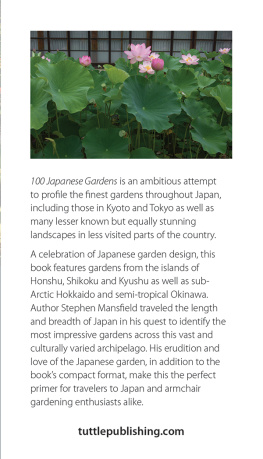

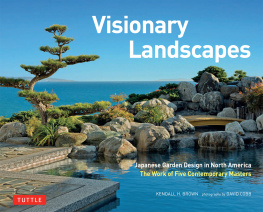

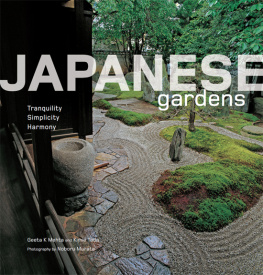
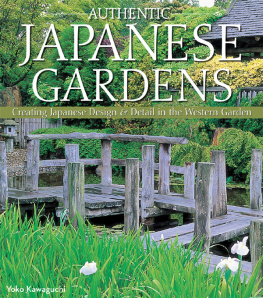

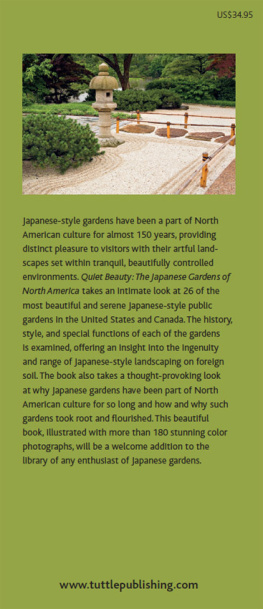

 ACKNOWLEDGMENTS
ACKNOWLEDGMENTS